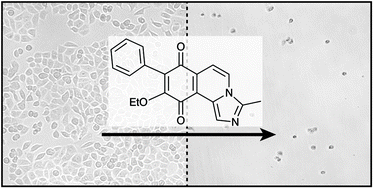Triggering apoptosis in cancer cells with an analogue of cribrostatin 6 that elevates intracellular ROS†
Abstract
Elevation of reactive oxygen species (ROS) is both a consequence and driver of the upregulated metabolism and proliferation of transformed cells. The resulting increase in oxidative stress is postulated to saturate the cellular antioxidant machinery, leaving cancer cells susceptible to agents that further elevate their intracellular oxidative stress. Several small molecules, including the marine natural product cribrostatin 6, have been demonstrated to trigger apoptosis in cancer cells by increasing intracellular ROS. Here, we report the modular synthesis of a series of cribrostatin 6 derivatives, and assessment of their activity in a number of cell lines. We establish that placing a phenyl ring on carbon 8 of cribrostatin 6 leads to increased potency, and observe a window of selectivity towards cancer cells. The mechanism of activity of this more potent analogue is assessed and demonstrated to induce apoptosis in cancer cells by increasing ROS. Our results demonstrate the potential for targeting tumors with molecules that enhance intracellular oxidative stress.



 Please wait while we load your content...
Please wait while we load your content...